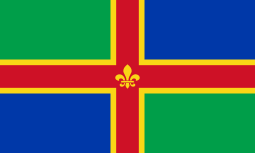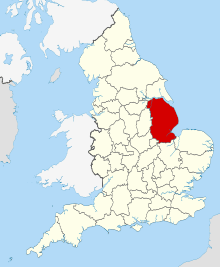Bardney Abbey
Bardney Abbey in Lincolnshire, England, was a Benedictine monastery founded in 697[1] by King Æthelred of Mercia, who was to become the first abbot. The monastery was supposedly destroyed during a Danish raid in 869.[2] In 1087, the site was refounded as a priory, by Gilbert de Gant, Earl of Lincoln, and it regained status as an abbey in 1115.[2][3][4]
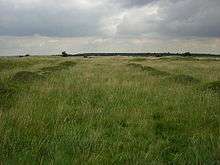
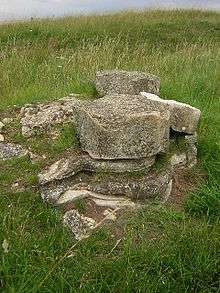
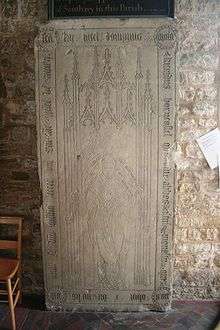
In 1537, six of the Bardney Abbey monks were executed for their role in the Lincolnshire Rising.[2][3][5] In 1538, the Abbey was disbanded and its property seized during the Dissolution of the Monasteries campaign started by Henry VIII. The property was then granted to Sir Robert Tirwhit.
Tirwhit retained the abbot's lodging as a house and converted the cloister into a garden. In later years, the lodging and garden became ruins along with the remainder of the former abbey.[5]
Excavations from 1909 through 1914 revealed the layout of Bardney Abbey. This can still be seen, though nothing remains to any height. Further excavations and conservation took place in 2009[6] and 2011.[7] Some grave slabs and carved stones are preserved in Bardney parish church, which is dedicated to St Lawrence.[8][9]
Relics of St Oswald
Bede relates that Bardney Abbey (which he called Beardaneu)[10] was greatly loved by Osthryth, queen of Mercia, and in about 679 she sought to move the bones of her uncle, the very pious St Oswald, to there.[11] However, when the body was brought to the Abbey the monks refused to accept it, because the Abbey was in the Kingdom of Lindsey, and Oswald, when king of Northumbria, had once conquered them. The relics were locked outside, but during the night a beam of light appeared and shone from his bier reaching up into the heavens. The monks declared that it was a miracle and accepted the body, hanging the King's Purple and Gold banner over the tomb.[10] They are also said to have removed the great doors to the Abbey so that such a mistake could not occur again. So if someone said "do you come from Bardney?", it meant that you had left the door open.[12][13][14]
As well as the wondrous light, other miracles were associated with the remains of King Oswald. The bones at Bardney were washed before interment and ground into which the water was poured supposedly gained great healing powers.[15] In another tale from Bede, a boy with the Ague kept vigil by the tomb and was cured.[16] The King's heads and hands had been separately interred, for he had been dismembered in battle.[15] A fragment of the stake on which his head had been impaled was later used to cure a man in Ireland.[17]
In 909, in response to increased viking raids, Oswald's bones were translated to the new St Oswald's Priory, Gloucester.[18]
Burials
- Oswald of Northumbria
- Æthelred of Mercia
- Osthryth
- Gilbert de Gant
- Alice de Montfort-sur-Risle, wife of Gilbert de Gant
- Maud of Brittany (daughter of Stephen, Count of Tréguier), wife of Walter de Gaunt
- Walter de Gant, father of Gilbert de Gant, Earl of Lincoln
- Alice de Gant, d. c. 1181 (daughter of Walter de Gant), wife of Roger de Mowbray (Lord of Montbray)
Known abbots of Bardney
This list is taken from the Victoria County History,[3] and Bowyer's History of the Mitred Parliamentary Abbies.[4]
Original foundation
- St. Ethelred, ex-king of Mercia, and founder of the abbey, made abbot about 704, died 716
- Kenewin, occurs 833
Benedictine foundation
- Ralf, prior in 1087, abbot 1115
- Ivo, occurs about 1133
- John of Ghent, elected 1140, occurs 1147 and 1150
- Walter, occurs 1155 to 1166
- John, occurs 1167
- Ralf of Stainfield, occurs 1180
- Robert, occurs 1191
- Ralf de Rand, occurs 1208, deposed 1214
- Peter of Lenton, intruded 1214
- Matthew, occurs 1218, died 1223
- Adam de Ascwardby, elected 1225, occurs 1231 and 1240
- William of Ripton
- Walter of Benningworth, elected 1241, deposed 1243
- William of Hatton, elected 1244
- William of Torksey, elected 1258, died 1266
- Peter of Barton, elected 1266, resigned 1280
- Robert of Wainfleet, elected 1280, resigned 1318[19]
- Richard of Gainsborough, elected 1318, died 1342
- Roger of Barrow, elected 1342, died 1355
- Thomas of Stapleton, elected 1355, died 1379
- Hugh of Braunston, elected 1379, resigned 1385
- John of Haynton, elected 1385
- John Woxbrigge, elected 1404, died 1413
- Geoffrey Hemingsby, elected 1413, died 1435
- John Wainfleet, elected 1435, died 1447[20]
- Gilbert Multon, elected 1447, resigned 1466
- Richard Horncastle, elected 1466, resigned 1507
- William Marton, last abbot, elected 1507
Further reading
- New, Anthony (1985). A guide to the abbeys of England and Wales. Constable. pp. 44–45. ISBN 0-09-463520-X. OCLC 246863338.
- "Bardney Abbey". Bardney Village History. Bardney Heritage Group. 2013. Retrieved 4 April 2013. Includes finds record and floor plan from 1909 excavation.
- Laing, Charles Edward (1913). Some notes on Bardney Abbey.
- An organisation called The Association of friends of Bardney Abbey existed from 1975 to 1993,[21] and published a number of monographs in the 1970s whose titles and authors are listed by a number of internet sources but the actual works are more elusive.
- Beech, George (1989). Patterson, Robert B (ed.). "Antiquarians and Flemings in the refoundation of Bardney Abbey (Lincolnshire) in the later 11th century". Haskins Society Journal. 1: 73–90. Retrieved 4 April 2013, describing the refoundation of the Abbey by Gilbert de Gant with monks from Charroux.
References
- This date comes from the National Monument record, but according to Bede the abbey already existed when Oswald was interred there in 679
- Historic England. "Bardney Abbey (351575)". PastScape. Retrieved 10 April 2010.
- "Houses of Benedictine monks: The abbey of Bardney". A History of the County of Lincoln: Volume 2. Victoria County History. 1906. pp. 97–104. Retrieved 3 April 2013.
- Bowyer, W. (1718). An History of the Mitred Parliamentary Abbies, and Conventual Cathedral Churches. Retrieved 4 April 2013.
- Historic England. "House and Garden (1058729)". PastScape. Retrieved 10 April 2010.
- Cope-Faulkener, Paul (December 2009). Archaeological evaluation at Bardney Abbey (BASM09 12/09) (PDF). Heckington: Archaeological Project Services. Retrieved 4 April 2013. Report on 2009 investigation, includes detailed floor plan.
- "Bardney Abbey Revealled 2011". Lincolnshire county council. Retrieved 3 April 2013.
- "New exhibition of sculpture from Bardney Abbey". Heritage Lottery Fund. 5 October 2012. Archived from the original on 14 July 2014. Retrieved 4 April 2013.
- "Bardney church". Bardney Heritage Group. Retrieved 3 April 2013.
- Bede. . Historia ecclesiastica gentis Anglorum. (as Leo Sherley-Price (trans.) (2008). The Ecclesiastical History of the English People. Penguin Classics. Penguin. p. 160.)
- Catholic Encyclopedia: St Oswald
- "Lincolnshire Heritage web page about the legend". Retrieved 12 September 2009.
- "Parish web site mentioning the legend". Retrieved 22 February 2011.
- "Local Authority history site, including the legend". Retrieved 12 February 2011.
- Bede iii.11
- Bede iii.12
- Bede iii.13
- Heighway, Carolyn (2001). "Gloucester and the new minster of St Oswald". In Higham, N. J.; Hill, D. H. (eds.). Edward the Elder 899-924. Routledge. p. 108.
- Historic England. "Benedictine Cell (1301846)". PastScape. Retrieved 4 April 2013.
- Thompson, Pishey (1820). Collections for a topographical and historical account of Boston, and the hundred of Skirbeck. Boston: J.Noble. p. 28.
- "The association of friends of Bardney Abbey". Charity Commission for England and Wales. 1993. Retrieved 4 April 2013.
| Wikimedia Commons has media related to Bardney Abbey. |
